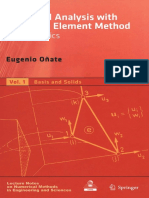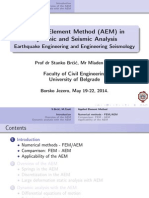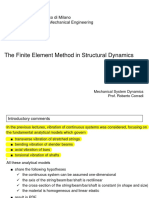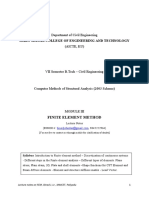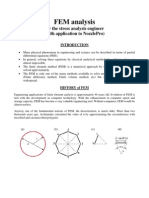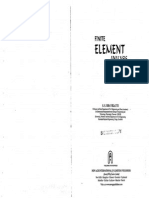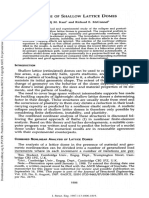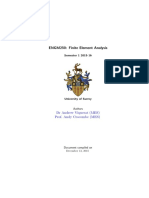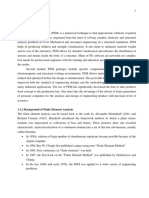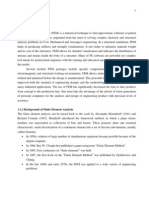0 ratings0% found this document useful (0 votes)
69 views15 pagesApplied Elements Methods
Applied elements methods
Uploaded by
Krayem WidoCopyright
© © All Rights Reserved
We take content rights seriously. If you suspect this is your content, claim it here.
Available Formats
Download as PDF or read online on Scribd
0 ratings0% found this document useful (0 votes)
69 views15 pagesApplied Elements Methods
Applied elements methods
Uploaded by
Krayem WidoCopyright
© © All Rights Reserved
We take content rights seriously. If you suspect this is your content, claim it here.
Available Formats
Download as PDF or read online on Scribd
You are on page 1/ 15
Structural Eng/Earthquake Eng. ISCE, Vol. 17, No, 1, 218—35s, 2000 Aprit
. Steuet. Mech, Earthquake Eng. JSCE, No, 647/151)
APPLIED ELEMENT METHOD FOR STRUCTURAL
ANALYSIS: THEORY AND APPLICATION FOR
LINEAR MATERIALS
Kimiro MEGURO' and Hatem TAGEL-DIN?
1 Dr. of Eng, Associate Prof, Intemational Center for Disaster-Mitigation Engincering (INCEDE),
Insitute of Industrial Science, The University of Tokyo
(4-6-1 Komaba, Meguro-ku, Tokyo 153-8505, Japan)
?Ph.D., Post-Doctorate Fellowship, Institute of Industrial Science, The University of Tokyo
‘A new method, Applied Element Method (AEM) for analysis of structures is introduced. The structure
is modeled as an assembly of distinct elements made by dividing the structural elements virtually. These
elements are connected by distributed springs in both normal and tangential directions. We introduce a
new method by which the total behavior of structures can be accurately simulated with reasonable CPU
time. This paper deals with the formulations used for linear elastic structures in small deformation range
and for consideration of the effects of Poisson's ratio. Comparing with theoretical results itis proved that
the new method is an efficient tool to follow mechanical behavior of structures in elastic conditions.
Key Words: Applied Element Method, AEM, confinement, Poisson's ratio, reinforced concrete,
computer simulation
1. INTRODUCTION
During earthquakes, buildings suffer from the
different types of damage. Structure damage is
classified into seven groups, as shown in Table 1,
according to the AIJ”. In the first five groups, partial
damage occurs to the structural and non-structural
elements without collapse of the structure. Partial
and complete collapse of structures is important
topic under research because it causes extensive
casualties inside and outside of the structures. In
addition, collapse of a structure may lead to failure
or collapse of near structures. Recent earthquakes,
like Hyogo-Ken Nanbu Earthquake, show that
structural failure was major cause of death toll”.
Although this topic is very important for safety of
people, current available methods for structural
analysis can not deal with this problem accurately.
‘Numerical methods for structural analysis can be
classified into two categories. In the first category,
model is based on continuum material equations.
The finite element method (FEM) is typical example
of this category. Smeared Crack approach” can not
be adopted in zones where separation occurs
between adjacent structural elements. While,
Discrete Crack Methods? assume that the location
and direction of crack propagation are predefined
before the analysis. With this group of the methods,
analysis of structures, especially concrete structures,
can be performed at most before collapse. The FEM
can answer only the following question ‘which is
"Will the structure fail or not?” Unfortunately, it is
very difficult to use the FEM for the second
portant question, which is "How does the
structure collapse?" Although displacement of
structural elements at failure may become tens of
meters, analysis using the FEM could be performed
till the start of failure, which means tens of
centimeters at most.
The second group of methods uses the discrete
element techniques, like the Rigid Body and Spring
Model (RBSM)” and the Extended Distinct Element
Method (EDEM?»®), The main advantage of these
methods is that they can simulate the cracking
process with relatively simple technique compared
to the FEM, while the main disadvantage is that
crack propagation depends mainly on the element
shape, size and arrangement”»®, Analysis using the
RBSM could not be performed up to complete
collapse of the structure. On the other hand, the
EDEM can follow the structural behavior from zero
loading and up to complete collapse of the structure.
However, the accuracy of EDEM in small
deformation range is less than that of the FEM.
3x(21s)
‘Table 1 Damage level of
structures as defined by the AJ”
Damage level
Damage of members
T- No damage No damage is found:
2: Slight damage | Columns, shear walls or non-structu
ral walls are slightly damaged
‘3: Light damage
‘Columns or shear walls are slightly damaged. Some shear cracks in non-structural walls are found,
Typical shear and flexural cracks in
4Moderate damage | structural walls are found,
‘columns, shear eracks in shear walls, or severe damage in non-
S- Heavy damage
‘Spalling of conerete, buckling of reinforcement, and crushing or shear falure in columns are found.
Lateral resistance of shear walls is reduced due to heavy shear cracks.
‘6-Partial collapse | The building is partially collapsed di
ue to severely damaged columns and/or shear walls
7. Total collapse
“The building is totally collapsed due to severely damaged columns and/or shear walls.
‘Table 2 Organization of research results
Hence, the failure behavior obtained by repeated
many calculations is affected due to cumulative
errors and can not be predicted accurately using the
EDEM. This means that the EDEM can answer only
the second question, "How does the structure
collapse?"
From the fact discussed above, we can say that
there is no proper method among current available
techniques by which total behavior of structures
from zero loading to collapse can be followed with
reliable accuracy and reasonable CPU time.
‘The major advantages of the proposed method
are simple modeling and programming, and high
accuracy of the results with relatively short CPU
time. Using the method, highly nonlinear behavior,
i.e. crack initiation, crack propagation, separation of
structural elements, rigid body motion of failed
elements and totally collapse process of the
structure can be followed with high accuracy”,
To cover a wide range of applications, analyses
should be performed for different fields of
application. The main factors affecting structural
analysis can be categorized as:
1. Effects of inertia forces: The loading types are
divided into two categories, static and dynamic
loading conditions. In dynamic loading case, the
inertia and damping forces should be taken into
account and hence, loading is a function of time.
Effects of the direction of loading: The analyses
are divided into two categories, monotonic and
cyclic loading conditions. In monotonic loading
condition, the load direction is constant while its
value increases, and in case of cyclic loading, the
load direction and values are changing.
32
Static Dynamic
Geometry ‘Material | Monotonic | Gyelic_| Monotonic | Cyelle
Small deformation |__Elastic | I(This paper) | yp
(inear) ‘Nonlinear 1?
Large deformation | Elastic Ww ve vie
(vontinear) ‘Noi ‘Covered in
Collapse process
3. Effects of geometrical changes: In some analyses,
the deformations are considered small with
respect to the structural dimensions. It can be
assumed that the structure geometry is constant
and effects of geometrical changes on the
stiffness matrix or internal forces are neglected.
In other cases, like buckling cases, deformations
are large and geometrical nonlinear behavior
should be discussed.
Effects of material properties: The material
behavior can be assumed as linear or nonlinear
behavior. In linear behavior, all stress-strain
relations are constant. In nonlinear case, cracking,
yield of the material and nonlinear stress-strain
relations should be considered.
The organization of the research is shown in
Table 2. This table shows all meaningful
application ranges which could be covered by the
proposed numerical model together with the
corresponding reference. The dark area indicates
that there is no meaning to perform simulation, like
simulation of collision effects in static loading
condition. In the lightly hatched area, application in
static loading conditions is not reasonable because
in case of nonlinear material, structural elements,
like concrete elements in large deformation range,
tend to separate. This indicates that the effects of
inertia forces and rigid body motions become
dominant. Therefore, this range is covered in
dynamics.
Main purposes of the paper are a) introduction of
background and outline of newly proposed model,
AEM, and b) formulation of fundamental parts of
the AEM. This is the first paper in a series of papers
(228)
TOY
(@) Element generation for AEM
Fig.
that cover all the application ranges shown in Table
2. Because of the limitation of the number of pages,
authors will publish whole research work through
several journal papers. In this paper, formulations
and verifications of the numerical technique in case
of elastic-static loading condition is introduced. In
additions, the effects of element size and number of
connecting springs is discussed. Moreover, the
numerical procedures to consider Poisson's ratio
effects are introduced.
2. ELEMENT FORMULATION
With the AEM, structure is modelled as an
assembly of small elements which are made by
dividing of the structure virtually, as shown in
1 (a). The two elements shown in Fig. 1 are
assumed to be connected by pairs of normal and
shear springs located at contact locations which are
distributed around the element edges. Each pair of
springs totally represent stresses and deformations
of a certain area (hatched area in Fig. 1 (b)) of the
studied elements. The spring stiffness is determined
as shown in Eq. (1):
ExdxT
a
and K, = 228xT
Ka= a
a
where, d is the distance between springs, T is the
thickness of the element and "a" is the length of the
representative area, E and G are the Young's and
shear modulus of the material, respectively. The
above equation indicates that each spring represents
the stiffness of an area (d x T) with length "a" of the
studied material. In case of reinforcement, this area
replaced by that of the reinforcement bar. The
above equation indicates that the spring stiffness is
calculated as if the spring connects the element
centerlines.
Normal nd Shea Springs
©
Spring distribution and area of influence
of each pair of springs
Modelling of structure to AEM
Fig.2 Element shape, contact location and degrees of freedom
Three degrees of freedom are assumed for each
element. These degrees of freedom represent the
tigid body motion of the element. Although the
element motion is a rigid body motion, its internal
stress and deformations can be calculated by the
spring deformation around each element. This
means that although the element shape doesn't
change during analysis, the behavior of assembly of
elements is deformable. The Poisson's ratio effect,
which is not considered in this formulation, is
illustrated in details in Section (6).
The two elements shown in Fig. 2 are assumed to
be connected by only one pair of normal (stiffness:
Kn) and shear (stiffness: Ks) springs. The values of
(dx and dy) correspond to the relative coordinate of
the contact point with respect to the centroid. To
have a general stiffness matrix, the location of
element and contact springs are assumed in a
general position. The stiffness matrix components
corresponding to each degree of freedom are
determined by assuming a unit displacement in the
studied direction and by determining forces at the
centroid of each element. The element stiffness
matrix size is only (6 x 6). Equation (2) shows the
components of the upper left quarter of the stiffness
matrix. All used notations in this equation are
33(238)
shown in Fig. 2, It is clear that the stiffness matrix
depends on the contact spring stiffness and the
spring location.
<=>
‘Read sila canon
[Steal omens dom, materi properies
ide munber of eomeriag rings es
SoHOeaKK, | Kasil e)en0e] Caray)
sco8(eraK, | +Ks8el0+aNCo(6+a) | Sele alto) SDewet loco! pepe of ch
FkeSalieoeoteoal] SeMGnahk, | Gedo al 6a ‘cnt t
Skesulecalndtoa)|seatiecaye, —_|sevadise)| (2) Ting honey ction
Cal atte) | Cale +aKyeCola) | Tear ree :
Snloredsicate) | Setecedetsee) | si35u2ye canine
The stiffness matrix in Eq. (2) is for only one
pair of contact springs. However, the global
stiffness matrix is determined by summing up the
stiffness matrices of individual pair of springs
around each element. Consequently, the developed
stiffness matrix is an average stiffness matrix for the
element according to the stress situation around the
element. This technique can be used both in load
and displacement control cases. The governing
equation is
ko J4]= FF] @)
where, [Kg] is the global stiffness matrix; [A] the
displacement vector and [F] the applied load vector.
In load control case, the vector, [F), is known before
the analysis. In displacement control case, the load
is applied by unit virtual displacement for one or
more degrees of freedom,
3. PROGRAM COMPOSITION
The flow chart of the method in elastic loading
condition is shown in Fig. 3. As the numbers of
elements and connecting springs are large, in the
program, the element location and spring data are
automatically generated based on the reinforcement
details of the structure before the analysis. In case of
reinforced concrete (RC) structures, the coordinates
of the springs representing the reinforcement bars
are defined by the nearest spring. For horizontal
reinforcement, "Y" coordinate is defined while for
vertical reinforcement, "X" coordinate is set. At the
location of reinforcement bar, two springs are set.
The first one is for steel bar while the other is for
concrete. It is assumed that both springs have the
same strain at each loading stage.
The idea of this technique is based on
transforming the global stiffness matrix, whose size
is (N x N), to another vector whose elements are the
non-zero elements of half of the original matrix, as
it is symmetrical. The solution of equations is
applied to the new vector. This technique has the
advantages that the memory capacity required for
storing the stiffness matrix data can be reduced and
that CPU time required for solving the equations is
drastically reduced because the calculations are
performed only to the non-zero elements. This
"element etn data
2 Reifrcment ba Sigs eon
[cae ste na
r
mee
Some
,
t
Cinta
t
[ence Save io dg piece
t
Caeser weer
t
< De tend
Fig. 3 Flow char ofthe program
advantage is very important in nonlinear analysis as
the stiffness matrix is reconstructed and solved
during each increment.
4. EFFECT OF NUMBER OF
CONNECTING SPRINGS BETWEEN
ELEMENTS
‘The number of connecting springs between
elements is one of the key factors that should be
taken into account. Obviously, in nonlinear analysis,
increasing the number of connecting springs
between elements leads to better results of crack
propagation, This section shows that the number of
connecting springs should be determined carefully
even in elastic analysis. Referring to Fig. 4, it is
assumed that "2n" springs are connecting two
elements together. Each spring represents the
stiffness of a distance of (b/2n). In translational
degrees of freedom case, the number of connecting
springs has no effect on the element stiffness as
decreasing the number of connecting springs leads
to increasing of area represented by each spring.
Finally, the total area becomes as the same as that
represented by one whole element. It means that one
spring can represent totally translational degrees of
freedom of an element but cannot do rotational
degree of freedom. Rotation of an element has effect
due to the number of springs and it is mainly
resisted by shear springs together with normal
34(248)
springs. Theoretical rotational stiffness, K,
calculated from normal springs is:
y=b/2 2
ETO’
K,= f
You might also like
- SRM Institute of Science and Technology: 18Mee305T - Finite Element MethodNo ratings yetSRM Institute of Science and Technology: 18Mee305T - Finite Element Method22 pages
- Structural Analysis With The Finite Element Method Linear Statics Volume 1, Basis and Solids - E.Oñate96% (28)Structural Analysis With The Finite Element Method Linear Statics Volume 1, Basis and Solids - E.Oñate495 pages
- Applied Element Method (AEM) in Dynamic and Seismic AnalysisNo ratings yetApplied Element Method (AEM) in Dynamic and Seismic Analysis75 pages
- Varying Shape, Boundary Conditions and Loads Solutions Obtained Are ApproximateNo ratings yetVarying Shape, Boundary Conditions and Loads Solutions Obtained Are Approximate17 pages
- Finite - Element Analysis Fundamentals: Emphasizes The Developments of Basic100% (2)Finite - Element Analysis Fundamentals: Emphasizes The Developments of Basic456 pages
- The Finite Element Method in Structural DynamicsNo ratings yetThe Finite Element Method in Structural Dynamics43 pages
- 3CL1201 Finite Element Method For Structural EngineeringNo ratings yet3CL1201 Finite Element Method For Structural Engineering38 pages
- CE6502 Finite Element Method in Structures - Course Outline 2019.20 IINo ratings yetCE6502 Finite Element Method in Structures - Course Outline 2019.20 II4 pages
- Structural Analysis With The Finite Element Method. Linear StaticsNo ratings yetStructural Analysis With The Finite Element Method. Linear Statics1 page
- Ling e Xiong (1991) - Rigid Finite Element MethodNo ratings yetLing e Xiong (1991) - Rigid Finite Element Method10 pages
- Finite Element Methods: Department: Civil Engineering Year & Sem: Iv B.Tech I Sem Subject: Finit Element MethodsNo ratings yetFinite Element Methods: Department: Civil Engineering Year & Sem: Iv B.Tech I Sem Subject: Finit Element Methods89 pages
- Artigo - Collapse of Shallow Lattice Domes - Kani & McConnel1987No ratings yetArtigo - Collapse of Shallow Lattice Domes - Kani & McConnel198714 pages
- Static and Dynamic Analysis of Collapse Behaviour of Steel StructuresNo ratings yetStatic and Dynamic Analysis of Collapse Behaviour of Steel Structures14 pages
- Assessment of Seismic Damage To Railway Structures Using Applied Element Method and Microtremor MeasurementNo ratings yetAssessment of Seismic Damage To Railway Structures Using Applied Element Method and Microtremor Measurement15 pages
- Analysis & Design of Prestressed Shell Type Structure Using Finite Element MethodNo ratings yetAnalysis & Design of Prestressed Shell Type Structure Using Finite Element Method7 pages
- NONLIN 7 05 Computer Program For NonlineNo ratings yetNONLIN 7 05 Computer Program For Nonline105 pages
- Prediction of Clearing Effects in Far-Field Blast Loading of Finite TargetsNo ratings yetPrediction of Clearing Effects in Far-Field Blast Loading of Finite Targets9 pages
- A Multi-Mode Shock Tube For Investigation of BlastNo ratings yetA Multi-Mode Shock Tube For Investigation of Blast11 pages





